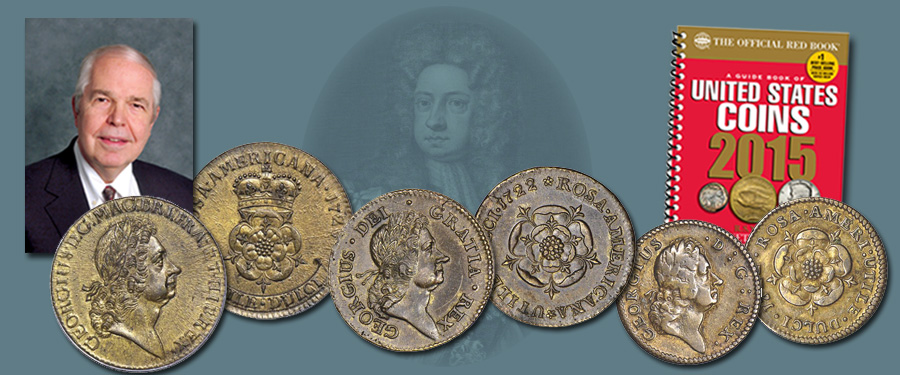
This week I continue my “tour” through the 2015 edition of A Guide Book of United States Coins, now starting with page 41. This week’s subject is William Wood, an English entrepreneur who in 1722 obtained a patent or franchise from King George I to make tokens to be distributed in Ireland and in America. Wood, a metallurgist in Wolverhampton, County of Stafford in England became interested in coinage as early as 1717, in which year he caused several patterns to be made in the denominations of halfpenny, penny and twopence. When he obtained the 1722 patent, this granted him the right to produce 100 tons of coins to be distributed in the “American Plantations.” It has been said that the Duchess of Kendall, a German baroness who endeared herself one way or another to the king, helped Wood secure the coining privilege in return for being paid £10,000. At the time there was a severe shortage of circulating coins in the American colonies, a situation that had prevailed ever since the first settlements had been made a century earlier. Most local and regional commerce was conducted in the barter system or with accounts of credits or in commodities that were assigned specific monetary values, including items from tobacco to musket balls to bushels of corn. In 1722 the coins in circulation in America were primarily issues from England, Spanish-America and the European continent. The colony of Massachusetts had produced silver coins beginning in 1652, but their quantities were not sufficient to sustain the needs of commerce.
Wood proposed that his coins for America be of an alloy consisting of 75% copper, 24.7% zinc and 0.3% silver, a mixture not used earlier. His patent from George I was to last 14 years. For the first four years of the contract no more than 20 tons were to be struck, and for the last 10 years no more than 10 tons in any given year. The coinage was done by a weighted drop press, in which the anvil or bottom die was secured and the top die was weighted and fell down to hit the planchet on top of the bottom die and create a coin. The 1762 book by Thomas Snelling, A View of the Silver Coins and Coinage of England, from our Norman Conquest to the Present Time, told this about the coinage of William Wood, naming others involved:
“We have also been informed that Kingsmill Eyres, Esq.; Mr. Marshland, a hardwareman in Cornhill, and several others were concerned in the scheme, the last mentioned person had great quantities of them in his cellar, was ruined by it, and died housekeeper at Gresham College; the dyes were engraved by Mr. Lammas, Mr. Standbroke, and Mr. Harold, some of which were in the possession of Mr. Winthorpe, who went to New-York, his father lies buried at Beckingham; they were struck at the French Change, in Hogg Lane, Seven Dials, by an engine that raised and let fall an heavy weight upon them when made hot, which is the most expeditious way of striking Bath metal, which was the sort of metal they were made of.”
Next week: More about the coinage of William Wood.





